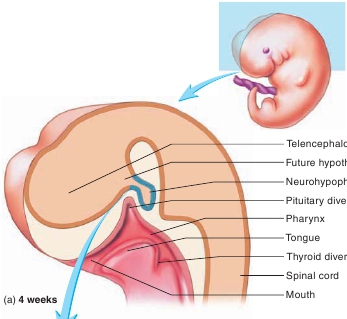CHAPTER 18 Endocrine Glands

603

Telencephalon of brain
hypothalamus
Neurohypophysial bud
diverticulum
diverticulum
Hypothalamus
(b)
8 weeks
(c)
16 weeks
neurohormones. The neurohormones released from theposterior pituitary are produced by neurosecretory neu-rons whose cell bodies are in the hypothalamus. Theaxons of these neurons extend from the hypothalamusthrough the infundibulum into the posterior pituitary andform a tract called the
hypothalamohypophysial tract
(figure 18.4). Neurohormones produced in the hypothala-mus pass down these axons in tiny vesicles and are storedin secretory vesicles in the ends of the axons. Actionpotentials originating in the neuron cell bodies in thehypothalamus are propagated along the axons to the axonterminals in the posterior pituitary. The action potentialscause the release of neurohormones from the axon termi-nals, and they enter the general circulation. Neurohor-mones of the posterior pituitary gland are described laterin this section.
Predict 2
Surgical removal of the posterior pituitary in experimentalanimals results in clear symptoms of a hormone shortage, but
4.
What is a portal system? Describe the hypotha-lamohypophysial portal system.
5.
How does the hypothalamus regulate thesecretion of anterior pituitary hormones?
6.
List the releasing and inhibiting hormones thatare produced and released from hypothalamicneurons.
7.
Describe the hypothalamohypophysial tract,including the production of neurohormones in thehypothalamus and their subsequent release fromthe posterior pituitary gland.
FIGURE 18.2
Development of the Pituitary Gland
The posterior pituitary develops as a downward growth of the hypothalamus. The ante-rior pituitary develops as an outpocketing of the embryonic gut called the pituitary diver-ticulum; the pars intermedia is not shown in this figure.
Many releasing and inhibiting hormones are produced andsecreted by hypothalamic neurons (table 18.1).
Growth hormone–releasing hormone (GHRH)
is a small peptide that stimulates thesecretion of growth hormone from the anterior pituitary gland, and
growth hormone–inhibiting hormone (GHIH),
also called
soma-tostatin
(s ō ′m ă -t ō -stat′in), is a small peptide that inhibits growth hor-mone secretion.
Thyrotropin-releasing hormone (TRH)
is a smallpeptide that stimulates the secretion of thyroid-stimulating hormonefrom the anterior pituitary gland.
Corticotropin-releasing hormone(CRH)
is a peptide that stimulates the secretion of adrenocorticotropichormone from the anterior pituitary gland.
Gonadotropin-releasinghormone (GnRH)
is a small peptide that stimulates the secretion ofboth luteinizing hormone and follicle-stimulating hormone from theanterior pituitary gland.
Prolactin-releasing hormone (PRH)
and
prolactin-inhibiting hormone (PIH)
regulate the secretion of prolac-tin from the anterior pituitary gland. Secretions of the anterior pitu-itary gland are described later in this section.Secretion of hormones by the posterior pituitary is very dif-ferent from that of the anterior pituitary. There is no portal systemto carry hypothalamic neuropeptides to the posterior pituitary.The posterior pituitary is simply a storage location for two
Hormones of the Pituitary Gland
The hormones secreted from the pituitary gland are separated intotwo categories: posterior pituitary hormones and anterior pituitaryhormones (table 18.2). Hormones from the pituitary gland havemany, varied effects on the body and exert these effects in severalways. In addition, there are major consequences of abnormal pitu-itary hormone secretion on the body.
Posterior Pituitary Hormones
Recall that the posterior pituitary is composed of neural tissue.Thus, the hormones stored and secreted by the posterior pitu-itary gland are the neurohormones, antidiuretic hormone andoxytocin. A separate population of neurons secretes eachneurohormone.